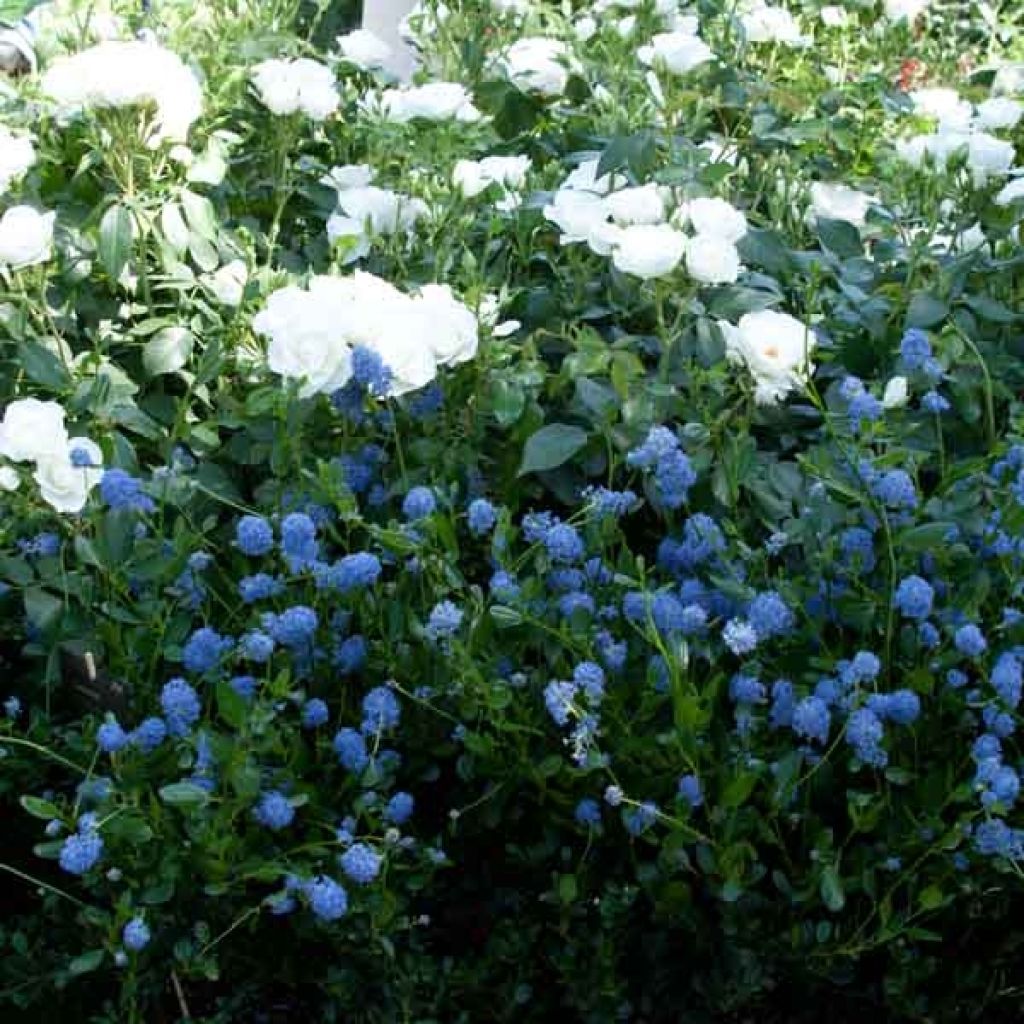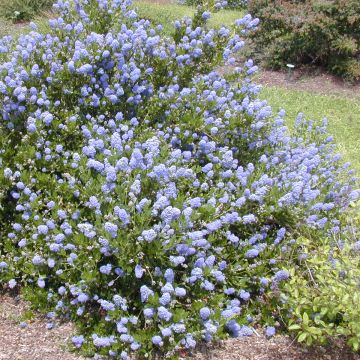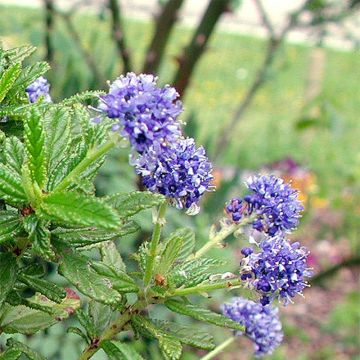

Ceanothus Skylark


Ceanothus Skylark


Ceanothus Skylark
Ceanothus Skylark
Ceanothus Skylark
California Lilac, Blue Blossom
This item cannot be shipped to the selected country
Delivery charge from €5.90
Delivery charge from €5.90
More information
Schedule delivery date,
and select date in basket
This plant carries a 24 months recovery warranty
More information
We guarantee the quality of our plants for a full growing cycle, and will replace at our expense any plant that fails to recover under normal climatic and planting conditions.
From €5.90 for pickup delivery and €6.90 for home delivery
Express home delivery from €8.90.
From €5.90 for pickup delivery and €6.90 for home delivery
Express home delivery from €8.90.

Does this plant fit my garden?
Set up your Plantfit profile →
Description
It is easy to see why Ceanothus 'Skylark' is one of the most planted California lilacs. This bushy shrub produces a long spring flowering, with deep blue, nectar-rich flower clusters, which are attractive to butterflies and bees. It tolerates summer drought and limestone, and it shows good hardiness for an evergreen ceanothus. Superb as a standalone plant, in a shrub bed or as a free hedge.
Ceanothus 'Skylark' is a horticultural hybrid probably derived from Ceanothus thyrsiflorus and C. velutinus. The first parent is native to California and Oregon. Its second parent is native to western North America, from British Columbia to California through Colorado. Ceanothus are part of the Rhamnaceae family, and are cousins of buckthorn (Frangula alnus). They do not tolerate wet soil; daily or too frequent watering will generally sign its death warrant.
'Skylark' has a bushy, slightly upright, dense, and flexible habit. It will reach about 2 m (6.6 ft) in all directions in about 6-7 years. Its lovely purple flower buds appear abundantly in May-June, at the tips of the branches, mingling with small dense panicles of fully opened flowers in a dazzling dark blue. The flowers measure 6 cm to 8 cm (2.4 in to 3.1 in) long. This abundant and fragrant flowering lasts for several weeks and attracts many pollinating insects. It is followed by the formation of seeds which, once mature, are released explosively. The evergreen foliage is dark green and glossy, and is composed of small alternate, elliptical, finely toothed leaves, measuring 2 cm to 5 cm (0.8 in to 2 in) long. They persist throughout the winter. This variety tolerates light pruning, just after flowering. Its average lifespan is 15 to 20 years. It does not tolerate clayey, heavy, and poorly drained soil. In well-drained soil, it can withstand temperatures down to -12° C to 15° C (10.4° F to 5° F) once well established.
In recent years, horticulturists have 'invented' beautiful varieties of ceanothus that are easier to acclimatise and have more modest dimensions, suitable for our gardens and terraces. Ceanothus 'Skylark' is a beautiful subject to plant alone or in a bed of easy-to-maintain shrubs in mild climates. Choose to plant it alongside Mexican orange, strawberry trees, coronillas, rock roses, bottlebrushes, and Escallonias. It is a very good plant for a dry garden without watering or a seaside garden.
Report an error about the product description
Ceanothus Skylark in pictures




Plant habit
Flowering
Foliage
Botanical data
Ceanothus
Skylark
Rhamnaceae
California Lilac, Blue Blossom
Cultivar or hybrid
Other Ceanothus
Planting and care
Place in a very sunny or partially shaded position (in the south or in hot regions). Plant in ordinary soil that must be moist to dry in summer, but absolutely well-drained. In very well-drained soil, 'Skylark' can withstand brief frosts of around -12° C to 15° C (10.4° F to 5° F) once established. It does not tolerate clayey, heavy, and very wet soils in winter. Limestone is also tolerated. Be careful of cold drafts; place it near a wall to protect it.
Plant it all year round, excluding frost, by mixing your garden soil with compost, coarse sand, gravel, perlite, or any material that doesn't retain moisture. Give it a generous watering once or twice a week to promote growth. In hot and dry climates, planting in early autumn is preferable. Only water twice a month from the third year onwards, and during prolonged summer drought. This is a plant that requires very little maintenance and grows without difficulty as long as the required conditions are met. Moisture in the soil during winter, as well as in the summer, is harmful to the plant. The combination of heat and humidity leads to the development of a fungus that attacks the bush's collar and will be fatal. In affected soils, it is better to plant Ceanothus on a mound. You can lightly prune the stems after flowering to encourage the plant to branch out. Fertiliser application is not recommended (just add a little horn at the bottom of the planting hole).
Pot cultivation:
Use a lightweight substrate, a mix of garden soil, coarse sand, and potting soil. In summer, water only when the soil is dry, but space out the waterings. The plant can be stored in a cool and bright place during winter, with little or no heating, protected from severe frosts. Apply a slow-release fertiliser in spring and autumn.
Planting period
Intended location
Care
-
, onOrder confirmed
Reply from on Promesse de fleurs
Evergreen shrubs
Haven't found what you were looking for?
Hardiness is the lowest winter temperature a plant can endure without suffering serious damage or even dying. However, hardiness is affected by location (a sheltered area, such as a patio), protection (winter cover) and soil type (hardiness is improved by well-drained soil).

Photo Sharing Terms & Conditions
In order to encourage gardeners to interact and share their experiences, Promesse de fleurs offers various media enabling content to be uploaded onto its Site - in particular via the ‘Photo sharing’ module.
The User agrees to refrain from:
- Posting any content that is illegal, prejudicial, insulting, racist, inciteful to hatred, revisionist, contrary to public decency, that infringes on privacy or on the privacy rights of third parties, in particular the publicity rights of persons and goods, intellectual property rights, or the right to privacy.
- Submitting content on behalf of a third party;
- Impersonate the identity of a third party and/or publish any personal information about a third party;
In general, the User undertakes to refrain from any unethical behaviour.
All Content (in particular text, comments, files, images, photos, videos, creative works, etc.), which may be subject to property or intellectual property rights, image or other private rights, shall remain the property of the User, subject to the limited rights granted by the terms of the licence granted by Promesse de fleurs as stated below. Users are at liberty to publish or not to publish such Content on the Site, notably via the ‘Photo Sharing’ facility, and accept that this Content shall be made public and freely accessible, notably on the Internet.
Users further acknowledge, undertake to have ,and guarantee that they hold all necessary rights and permissions to publish such material on the Site, in particular with regard to the legislation in force pertaining to any privacy, property, intellectual property, image, or contractual rights, or rights of any other nature. By publishing such Content on the Site, Users acknowledge accepting full liability as publishers of the Content within the meaning of the law, and grant Promesse de fleurs, free of charge, an inclusive, worldwide licence for the said Content for the entire duration of its publication, including all reproduction, representation, up/downloading, displaying, performing, transmission, and storage rights.
Users also grant permission for their name to be linked to the Content and accept that this link may not always be made available.
By engaging in posting material, Users consent to their Content becoming automatically accessible on the Internet, in particular on other sites and/or blogs and/or web pages of the Promesse de fleurs site, including in particular social pages and the Promesse de fleurs catalogue.
Users may secure the removal of entrusted content free of charge by issuing a simple request via our contact form.
The flowering period indicated on our website applies to countries and regions located in USDA zone 8 (France, the United Kingdom, Ireland, the Netherlands, etc.)
It will vary according to where you live:
- In zones 9 to 10 (Italy, Spain, Greece, etc.), flowering will occur about 2 to 4 weeks earlier.
- In zones 6 to 7 (Germany, Poland, Slovenia, and lower mountainous regions), flowering will be delayed by 2 to 3 weeks.
- In zone 5 (Central Europe, Scandinavia), blooming will be delayed by 3 to 5 weeks.
In temperate climates, pruning of spring-flowering shrubs (forsythia, spireas, etc.) should be done just after flowering.
Pruning of summer-flowering shrubs (Indian Lilac, Perovskia, etc.) can be done in winter or spring.
In cold regions as well as with frost-sensitive plants, avoid pruning too early when severe frosts may still occur.
The planting period indicated on our website applies to countries and regions located in USDA zone 8 (France, United Kingdom, Ireland, Netherlands).
It will vary according to where you live:
- In Mediterranean zones (Marseille, Madrid, Milan, etc.), autumn and winter are the best planting periods.
- In continental zones (Strasbourg, Munich, Vienna, etc.), delay planting by 2 to 3 weeks in spring and bring it forward by 2 to 4 weeks in autumn.
- In mountainous regions (the Alps, Pyrenees, Carpathians, etc.), it is best to plant in late spring (May-June) or late summer (August-September).
The harvesting period indicated on our website applies to countries and regions in USDA zone 8 (France, England, Ireland, the Netherlands).
In colder areas (Scandinavia, Poland, Austria...) fruit and vegetable harvests are likely to be delayed by 3-4 weeks.
In warmer areas (Italy, Spain, Greece, etc.), harvesting will probably take place earlier, depending on weather conditions.
The sowing periods indicated on our website apply to countries and regions within USDA Zone 8 (France, UK, Ireland, Netherlands).
In colder areas (Scandinavia, Poland, Austria...), delay any outdoor sowing by 3-4 weeks, or sow under glass.
In warmer climes (Italy, Spain, Greece, etc.), bring outdoor sowing forward by a few weeks.




















































